Unit 3 Assignment: Gender Diversity in Public Service Organizations
VerifiedAdded on 2022/08/20
|8
|2040
|17
Report
AI Summary
This report addresses the critical issue of gender diversity, specifically its impact on decision-making processes within public service organizations, using police departments in the United States as a case study. The paper identifies the lack of gender diversity as a complex problem, examining its effects on organizational performance, employee motivation, and innovation. It explores the influence of organizational culture and statistical discrimination on gender inequality, highlighting the underrepresentation of women in leadership positions. The report investigates the role of collaboration and communication in promoting gender diversity, particularly within law enforcement agencies, and emphasizes the importance of gender training and inclusive organizational structures. It concludes by advocating for measures to remove barriers and improve gender impartiality in the workplace, with the inclusion of women in decision-making roles. The report also provides a comprehensive analysis of the background of the problem, including historical and current research, assumptions, evidence, and implications for relationships and partnerships within the public service sector. The report also includes a review of the challenges women face in police departments, relating them to wider societal issues, and suggesting the need for long-term, sustainable solutions.

Running head: DIVERSITY, ETHICS AND CULTURAL COMPETENCY
Unit 3 Assignment: Problem Identification and Background
Sharon Richie
Capella University
Prof Prac Collab Div Dyn World
Dr. Mary Lannon
Unit 3 Assignment: Problem Identification and Background
Sharon Richie
Capella University
Prof Prac Collab Div Dyn World
Dr. Mary Lannon
Paraphrase This Document
Need a fresh take? Get an instant paraphrase of this document with our AI Paraphraser
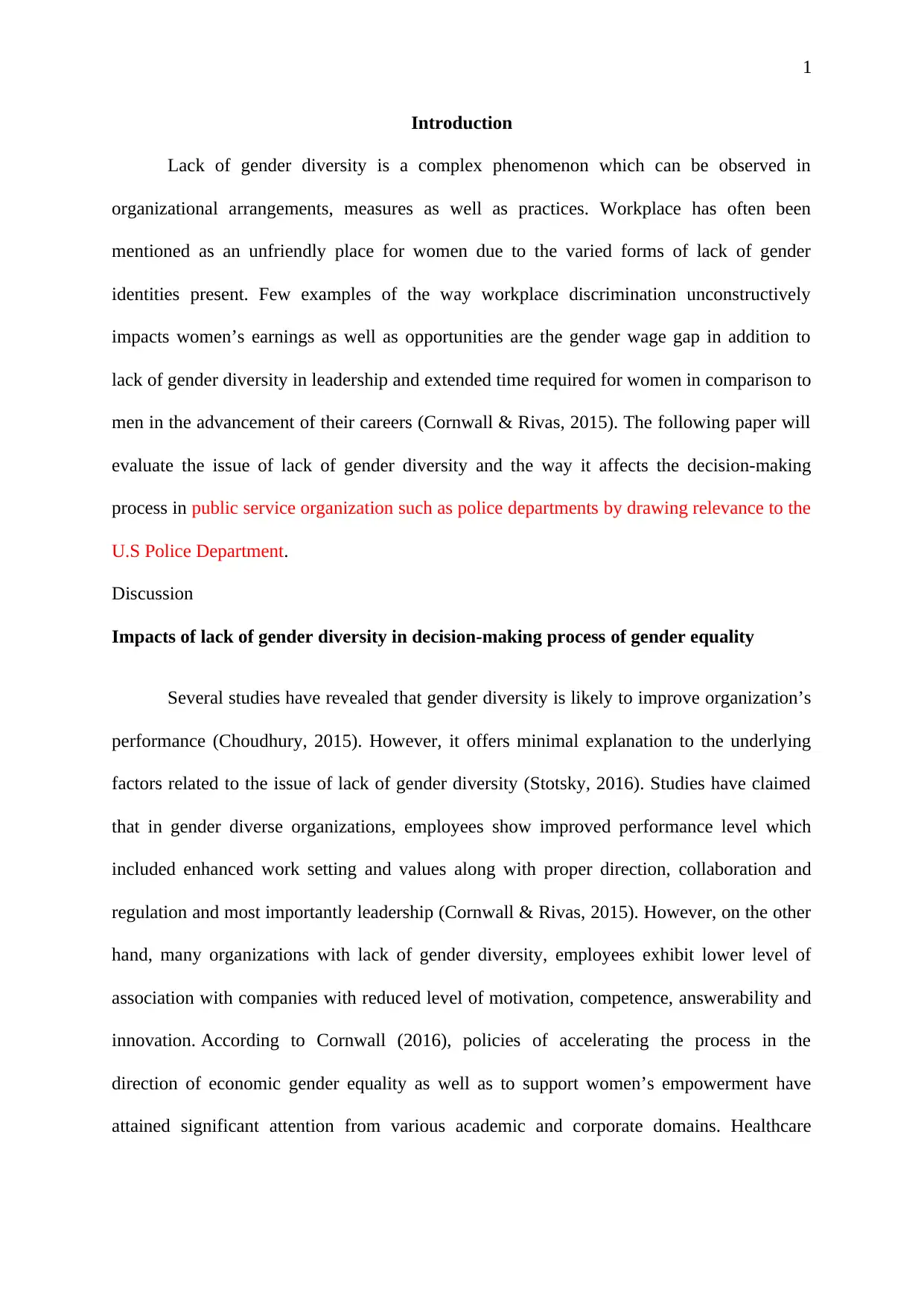
1
Introduction
Lack of gender diversity is a complex phenomenon which can be observed in
organizational arrangements, measures as well as practices. Workplace has often been
mentioned as an unfriendly place for women due to the varied forms of lack of gender
identities present. Few examples of the way workplace discrimination unconstructively
impacts women’s earnings as well as opportunities are the gender wage gap in addition to
lack of gender diversity in leadership and extended time required for women in comparison to
men in the advancement of their careers (Cornwall & Rivas, 2015). The following paper will
evaluate the issue of lack of gender diversity and the way it affects the decision-making
process in public service organization such as police departments by drawing relevance to the
U.S Police Department.
Discussion
Impacts of lack of gender diversity in decision-making process of gender equality
Several studies have revealed that gender diversity is likely to improve organization’s
performance (Choudhury, 2015). However, it offers minimal explanation to the underlying
factors related to the issue of lack of gender diversity (Stotsky, 2016). Studies have claimed
that in gender diverse organizations, employees show improved performance level which
included enhanced work setting and values along with proper direction, collaboration and
regulation and most importantly leadership (Cornwall & Rivas, 2015). However, on the other
hand, many organizations with lack of gender diversity, employees exhibit lower level of
association with companies with reduced level of motivation, competence, answerability and
innovation. According to Cornwall (2016), policies of accelerating the process in the
direction of economic gender equality as well as to support women’s empowerment have
attained significant attention from various academic and corporate domains. Healthcare
Introduction
Lack of gender diversity is a complex phenomenon which can be observed in
organizational arrangements, measures as well as practices. Workplace has often been
mentioned as an unfriendly place for women due to the varied forms of lack of gender
identities present. Few examples of the way workplace discrimination unconstructively
impacts women’s earnings as well as opportunities are the gender wage gap in addition to
lack of gender diversity in leadership and extended time required for women in comparison to
men in the advancement of their careers (Cornwall & Rivas, 2015). The following paper will
evaluate the issue of lack of gender diversity and the way it affects the decision-making
process in public service organization such as police departments by drawing relevance to the
U.S Police Department.
Discussion
Impacts of lack of gender diversity in decision-making process of gender equality
Several studies have revealed that gender diversity is likely to improve organization’s
performance (Choudhury, 2015). However, it offers minimal explanation to the underlying
factors related to the issue of lack of gender diversity (Stotsky, 2016). Studies have claimed
that in gender diverse organizations, employees show improved performance level which
included enhanced work setting and values along with proper direction, collaboration and
regulation and most importantly leadership (Cornwall & Rivas, 2015). However, on the other
hand, many organizations with lack of gender diversity, employees exhibit lower level of
association with companies with reduced level of motivation, competence, answerability and
innovation. According to Cornwall (2016), policies of accelerating the process in the
direction of economic gender equality as well as to support women’s empowerment have
attained significant attention from various academic and corporate domains. Healthcare
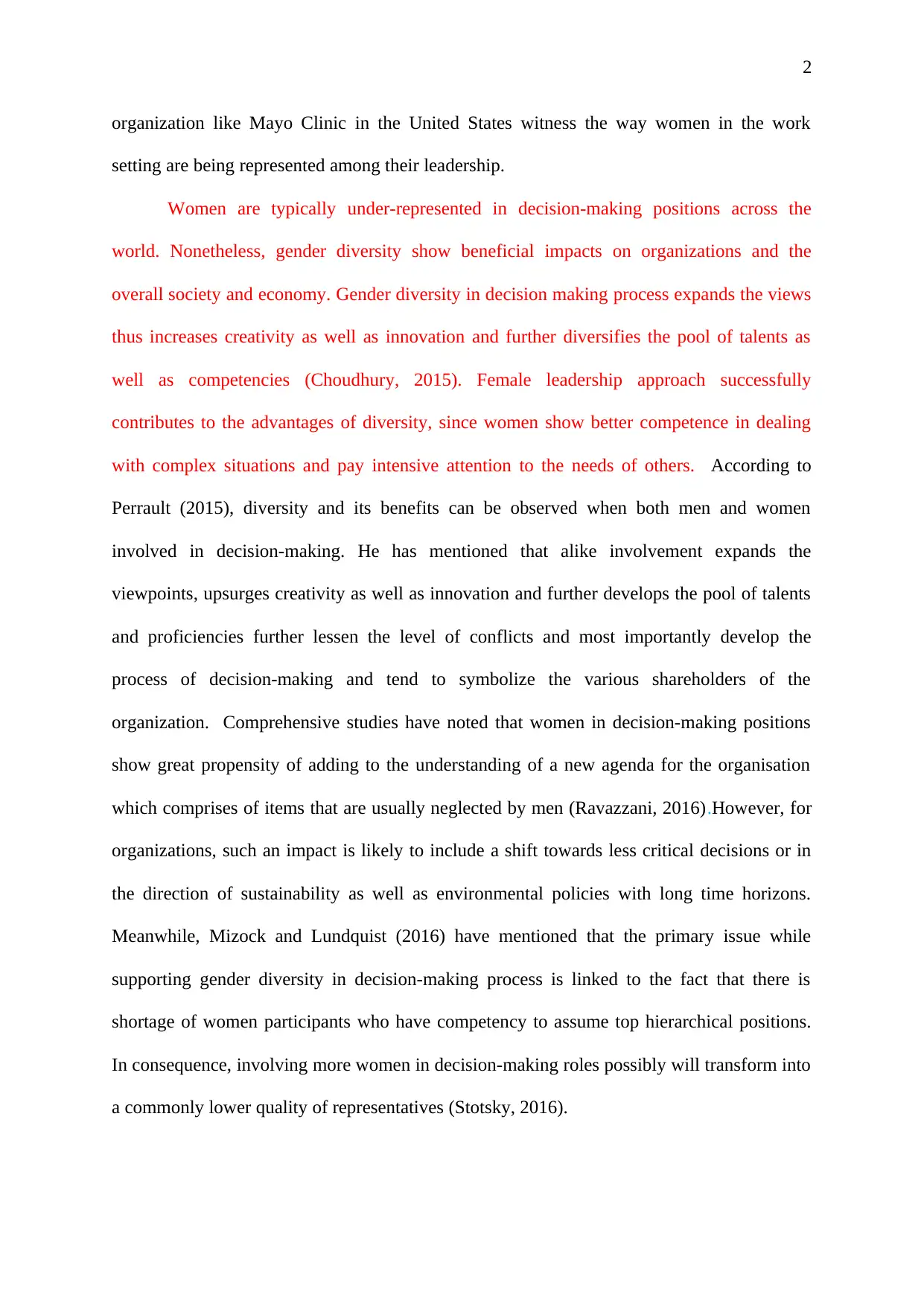
2
organization like Mayo Clinic in the United States witness the way women in the work
setting are being represented among their leadership.
Women are typically under-represented in decision-making positions across the
world. Nonetheless, gender diversity show beneficial impacts on organizations and the
overall society and economy. Gender diversity in decision making process expands the views
thus increases creativity as well as innovation and further diversifies the pool of talents as
well as competencies (Choudhury, 2015). Female leadership approach successfully
contributes to the advantages of diversity, since women show better competence in dealing
with complex situations and pay intensive attention to the needs of others. According to
Perrault (2015), diversity and its benefits can be observed when both men and women
involved in decision-making. He has mentioned that alike involvement expands the
viewpoints, upsurges creativity as well as innovation and further develops the pool of talents
and proficiencies further lessen the level of conflicts and most importantly develop the
process of decision-making and tend to symbolize the various shareholders of the
organization. Comprehensive studies have noted that women in decision-making positions
show great propensity of adding to the understanding of a new agenda for the organisation
which comprises of items that are usually neglected by men (Ravazzani, 2016).However, for
organizations, such an impact is likely to include a shift towards less critical decisions or in
the direction of sustainability as well as environmental policies with long time horizons.
Meanwhile, Mizock and Lundquist (2016) have mentioned that the primary issue while
supporting gender diversity in decision-making process is linked to the fact that there is
shortage of women participants who have competency to assume top hierarchical positions.
In consequence, involving more women in decision-making roles possibly will transform into
a commonly lower quality of representatives (Stotsky, 2016).
organization like Mayo Clinic in the United States witness the way women in the work
setting are being represented among their leadership.
Women are typically under-represented in decision-making positions across the
world. Nonetheless, gender diversity show beneficial impacts on organizations and the
overall society and economy. Gender diversity in decision making process expands the views
thus increases creativity as well as innovation and further diversifies the pool of talents as
well as competencies (Choudhury, 2015). Female leadership approach successfully
contributes to the advantages of diversity, since women show better competence in dealing
with complex situations and pay intensive attention to the needs of others. According to
Perrault (2015), diversity and its benefits can be observed when both men and women
involved in decision-making. He has mentioned that alike involvement expands the
viewpoints, upsurges creativity as well as innovation and further develops the pool of talents
and proficiencies further lessen the level of conflicts and most importantly develop the
process of decision-making and tend to symbolize the various shareholders of the
organization. Comprehensive studies have noted that women in decision-making positions
show great propensity of adding to the understanding of a new agenda for the organisation
which comprises of items that are usually neglected by men (Ravazzani, 2016).However, for
organizations, such an impact is likely to include a shift towards less critical decisions or in
the direction of sustainability as well as environmental policies with long time horizons.
Meanwhile, Mizock and Lundquist (2016) have mentioned that the primary issue while
supporting gender diversity in decision-making process is linked to the fact that there is
shortage of women participants who have competency to assume top hierarchical positions.
In consequence, involving more women in decision-making roles possibly will transform into
a commonly lower quality of representatives (Stotsky, 2016).
⊘ This is a preview!⊘
Do you want full access?
Subscribe today to unlock all pages.

Trusted by 1+ million students worldwide
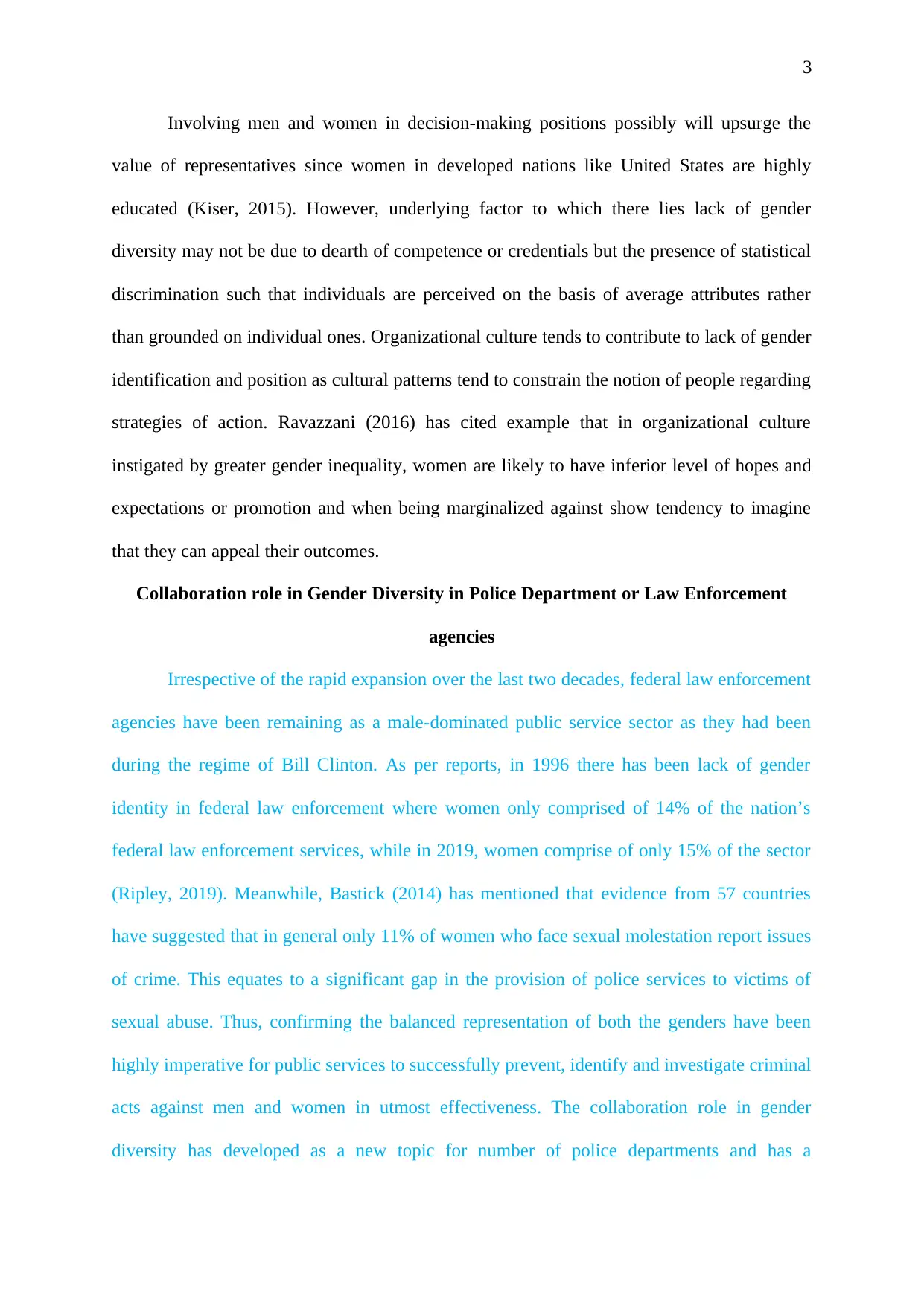
3
Involving men and women in decision-making positions possibly will upsurge the
value of representatives since women in developed nations like United States are highly
educated (Kiser, 2015). However, underlying factor to which there lies lack of gender
diversity may not be due to dearth of competence or credentials but the presence of statistical
discrimination such that individuals are perceived on the basis of average attributes rather
than grounded on individual ones. Organizational culture tends to contribute to lack of gender
identification and position as cultural patterns tend to constrain the notion of people regarding
strategies of action. Ravazzani (2016) has cited example that in organizational culture
instigated by greater gender inequality, women are likely to have inferior level of hopes and
expectations or promotion and when being marginalized against show tendency to imagine
that they can appeal their outcomes.
Collaboration role in Gender Diversity in Police Department or Law Enforcement
agencies
Irrespective of the rapid expansion over the last two decades, federal law enforcement
agencies have been remaining as a male-dominated public service sector as they had been
during the regime of Bill Clinton. As per reports, in 1996 there has been lack of gender
identity in federal law enforcement where women only comprised of 14% of the nation’s
federal law enforcement services, while in 2019, women comprise of only 15% of the sector
(Ripley, 2019). Meanwhile, Bastick (2014) has mentioned that evidence from 57 countries
have suggested that in general only 11% of women who face sexual molestation report issues
of crime. This equates to a significant gap in the provision of police services to victims of
sexual abuse. Thus, confirming the balanced representation of both the genders have been
highly imperative for public services to successfully prevent, identify and investigate criminal
acts against men and women in utmost effectiveness. The collaboration role in gender
diversity has developed as a new topic for number of police departments and has a
Involving men and women in decision-making positions possibly will upsurge the
value of representatives since women in developed nations like United States are highly
educated (Kiser, 2015). However, underlying factor to which there lies lack of gender
diversity may not be due to dearth of competence or credentials but the presence of statistical
discrimination such that individuals are perceived on the basis of average attributes rather
than grounded on individual ones. Organizational culture tends to contribute to lack of gender
identification and position as cultural patterns tend to constrain the notion of people regarding
strategies of action. Ravazzani (2016) has cited example that in organizational culture
instigated by greater gender inequality, women are likely to have inferior level of hopes and
expectations or promotion and when being marginalized against show tendency to imagine
that they can appeal their outcomes.
Collaboration role in Gender Diversity in Police Department or Law Enforcement
agencies
Irrespective of the rapid expansion over the last two decades, federal law enforcement
agencies have been remaining as a male-dominated public service sector as they had been
during the regime of Bill Clinton. As per reports, in 1996 there has been lack of gender
identity in federal law enforcement where women only comprised of 14% of the nation’s
federal law enforcement services, while in 2019, women comprise of only 15% of the sector
(Ripley, 2019). Meanwhile, Bastick (2014) has mentioned that evidence from 57 countries
have suggested that in general only 11% of women who face sexual molestation report issues
of crime. This equates to a significant gap in the provision of police services to victims of
sexual abuse. Thus, confirming the balanced representation of both the genders have been
highly imperative for public services to successfully prevent, identify and investigate criminal
acts against men and women in utmost effectiveness. The collaboration role in gender
diversity has developed as a new topic for number of police departments and has a
Paraphrase This Document
Need a fresh take? Get an instant paraphrase of this document with our AI Paraphraser
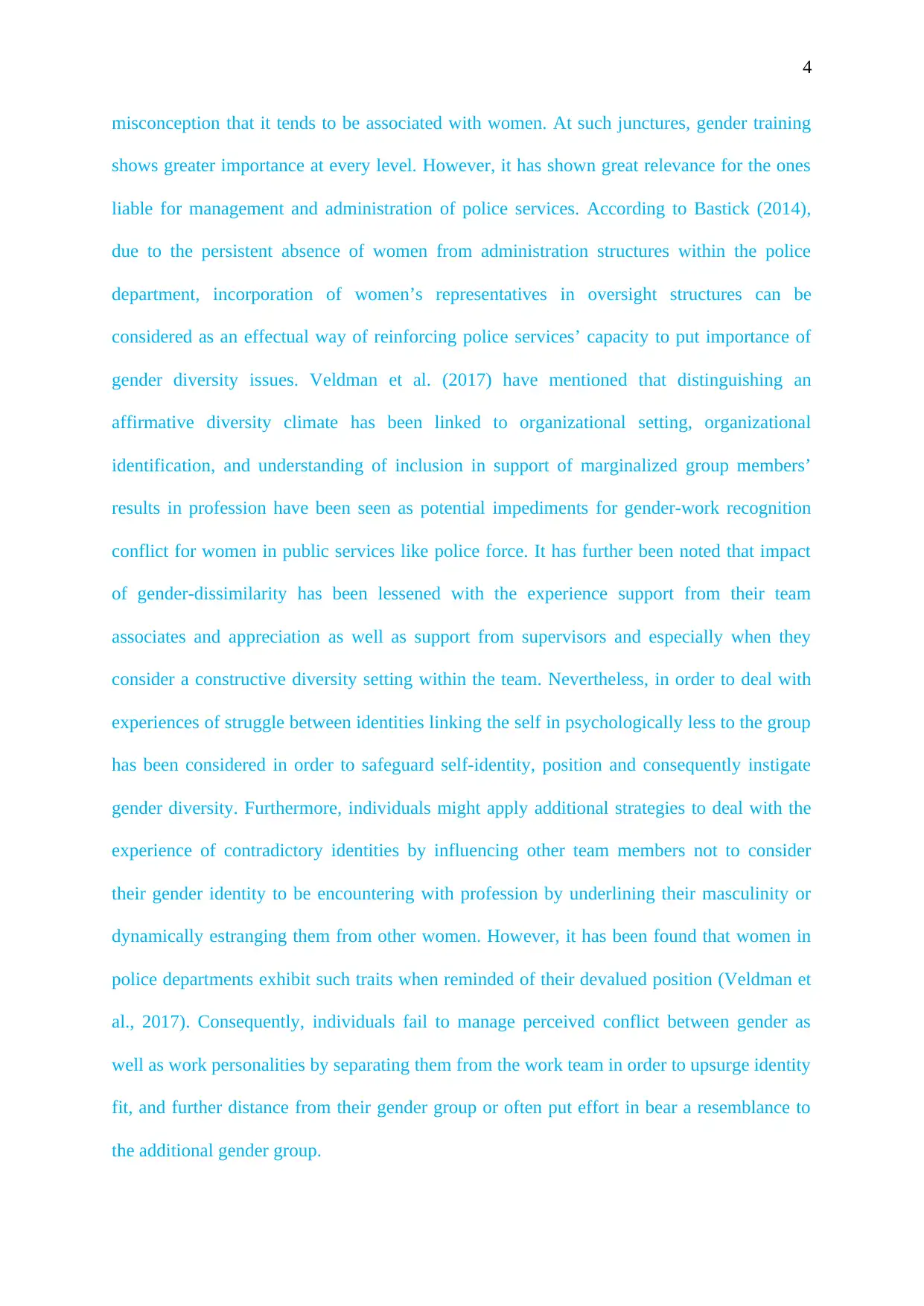
4
misconception that it tends to be associated with women. At such junctures, gender training
shows greater importance at every level. However, it has shown great relevance for the ones
liable for management and administration of police services. According to Bastick (2014),
due to the persistent absence of women from administration structures within the police
department, incorporation of women’s representatives in oversight structures can be
considered as an effectual way of reinforcing police services’ capacity to put importance of
gender diversity issues. Veldman et al. (2017) have mentioned that distinguishing an
affirmative diversity climate has been linked to organizational setting, organizational
identification, and understanding of inclusion in support of marginalized group members’
results in profession have been seen as potential impediments for gender-work recognition
conflict for women in public services like police force. It has further been noted that impact
of gender-dissimilarity has been lessened with the experience support from their team
associates and appreciation as well as support from supervisors and especially when they
consider a constructive diversity setting within the team. Nevertheless, in order to deal with
experiences of struggle between identities linking the self in psychologically less to the group
has been considered in order to safeguard self-identity, position and consequently instigate
gender diversity. Furthermore, individuals might apply additional strategies to deal with the
experience of contradictory identities by influencing other team members not to consider
their gender identity to be encountering with profession by underlining their masculinity or
dynamically estranging them from other women. However, it has been found that women in
police departments exhibit such traits when reminded of their devalued position (Veldman et
al., 2017). Consequently, individuals fail to manage perceived conflict between gender as
well as work personalities by separating them from the work team in order to upsurge identity
fit, and further distance from their gender group or often put effort in bear a resemblance to
the additional gender group.
misconception that it tends to be associated with women. At such junctures, gender training
shows greater importance at every level. However, it has shown great relevance for the ones
liable for management and administration of police services. According to Bastick (2014),
due to the persistent absence of women from administration structures within the police
department, incorporation of women’s representatives in oversight structures can be
considered as an effectual way of reinforcing police services’ capacity to put importance of
gender diversity issues. Veldman et al. (2017) have mentioned that distinguishing an
affirmative diversity climate has been linked to organizational setting, organizational
identification, and understanding of inclusion in support of marginalized group members’
results in profession have been seen as potential impediments for gender-work recognition
conflict for women in public services like police force. It has further been noted that impact
of gender-dissimilarity has been lessened with the experience support from their team
associates and appreciation as well as support from supervisors and especially when they
consider a constructive diversity setting within the team. Nevertheless, in order to deal with
experiences of struggle between identities linking the self in psychologically less to the group
has been considered in order to safeguard self-identity, position and consequently instigate
gender diversity. Furthermore, individuals might apply additional strategies to deal with the
experience of contradictory identities by influencing other team members not to consider
their gender identity to be encountering with profession by underlining their masculinity or
dynamically estranging them from other women. However, it has been found that women in
police departments exhibit such traits when reminded of their devalued position (Veldman et
al., 2017). Consequently, individuals fail to manage perceived conflict between gender as
well as work personalities by separating them from the work team in order to upsurge identity
fit, and further distance from their gender group or often put effort in bear a resemblance to
the additional gender group.
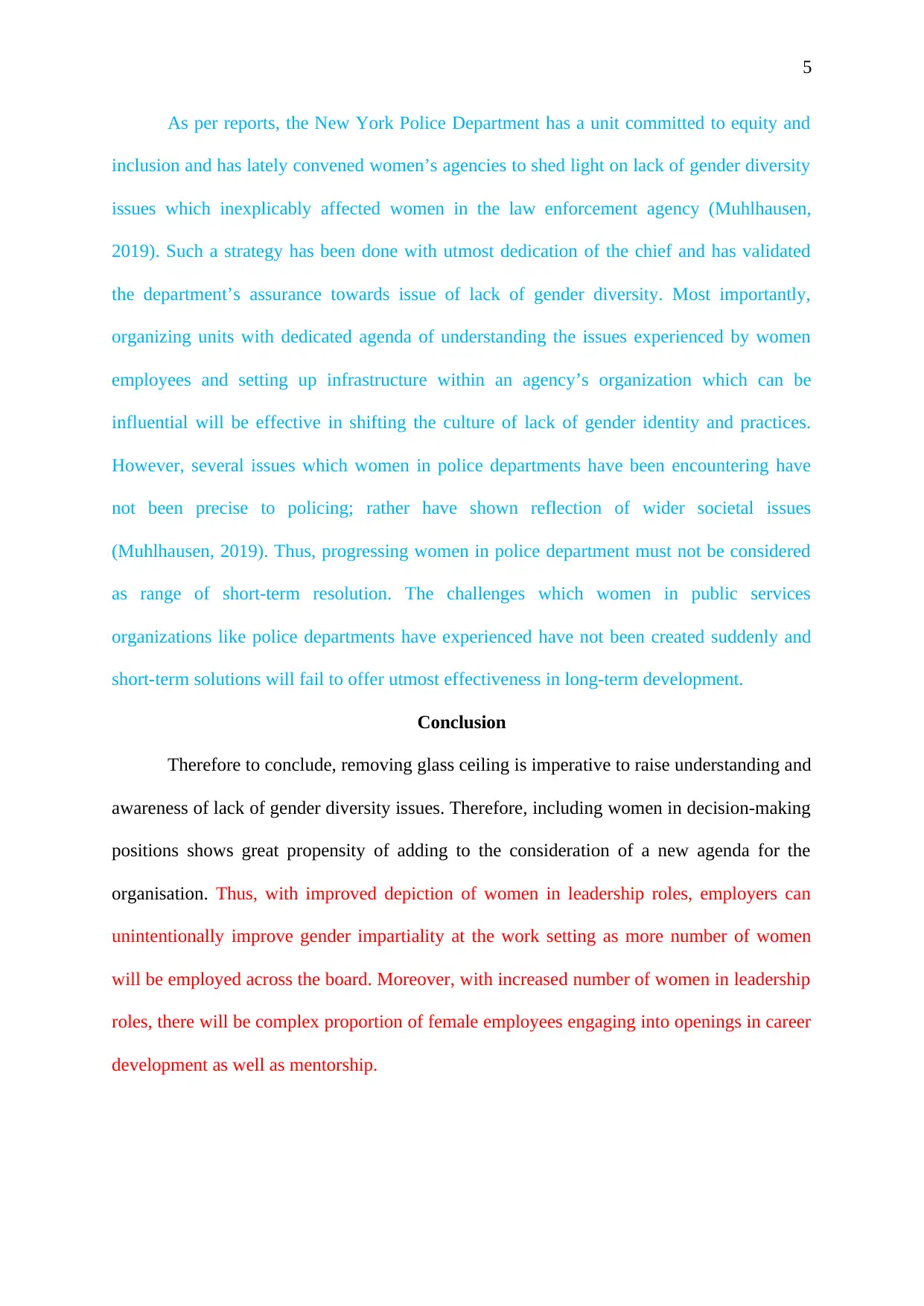
5
As per reports, the New York Police Department has a unit committed to equity and
inclusion and has lately convened women’s agencies to shed light on lack of gender diversity
issues which inexplicably affected women in the law enforcement agency (Muhlhausen,
2019). Such a strategy has been done with utmost dedication of the chief and has validated
the department’s assurance towards issue of lack of gender diversity. Most importantly,
organizing units with dedicated agenda of understanding the issues experienced by women
employees and setting up infrastructure within an agency’s organization which can be
influential will be effective in shifting the culture of lack of gender identity and practices.
However, several issues which women in police departments have been encountering have
not been precise to policing; rather have shown reflection of wider societal issues
(Muhlhausen, 2019). Thus, progressing women in police department must not be considered
as range of short-term resolution. The challenges which women in public services
organizations like police departments have experienced have not been created suddenly and
short-term solutions will fail to offer utmost effectiveness in long-term development.
Conclusion
Therefore to conclude, removing glass ceiling is imperative to raise understanding and
awareness of lack of gender diversity issues. Therefore, including women in decision-making
positions shows great propensity of adding to the consideration of a new agenda for the
organisation. Thus, with improved depiction of women in leadership roles, employers can
unintentionally improve gender impartiality at the work setting as more number of women
will be employed across the board. Moreover, with increased number of women in leadership
roles, there will be complex proportion of female employees engaging into openings in career
development as well as mentorship.
As per reports, the New York Police Department has a unit committed to equity and
inclusion and has lately convened women’s agencies to shed light on lack of gender diversity
issues which inexplicably affected women in the law enforcement agency (Muhlhausen,
2019). Such a strategy has been done with utmost dedication of the chief and has validated
the department’s assurance towards issue of lack of gender diversity. Most importantly,
organizing units with dedicated agenda of understanding the issues experienced by women
employees and setting up infrastructure within an agency’s organization which can be
influential will be effective in shifting the culture of lack of gender identity and practices.
However, several issues which women in police departments have been encountering have
not been precise to policing; rather have shown reflection of wider societal issues
(Muhlhausen, 2019). Thus, progressing women in police department must not be considered
as range of short-term resolution. The challenges which women in public services
organizations like police departments have experienced have not been created suddenly and
short-term solutions will fail to offer utmost effectiveness in long-term development.
Conclusion
Therefore to conclude, removing glass ceiling is imperative to raise understanding and
awareness of lack of gender diversity issues. Therefore, including women in decision-making
positions shows great propensity of adding to the consideration of a new agenda for the
organisation. Thus, with improved depiction of women in leadership roles, employers can
unintentionally improve gender impartiality at the work setting as more number of women
will be employed across the board. Moreover, with increased number of women in leadership
roles, there will be complex proportion of female employees engaging into openings in career
development as well as mentorship.
⊘ This is a preview!⊘
Do you want full access?
Subscribe today to unlock all pages.

Trusted by 1+ million students worldwide
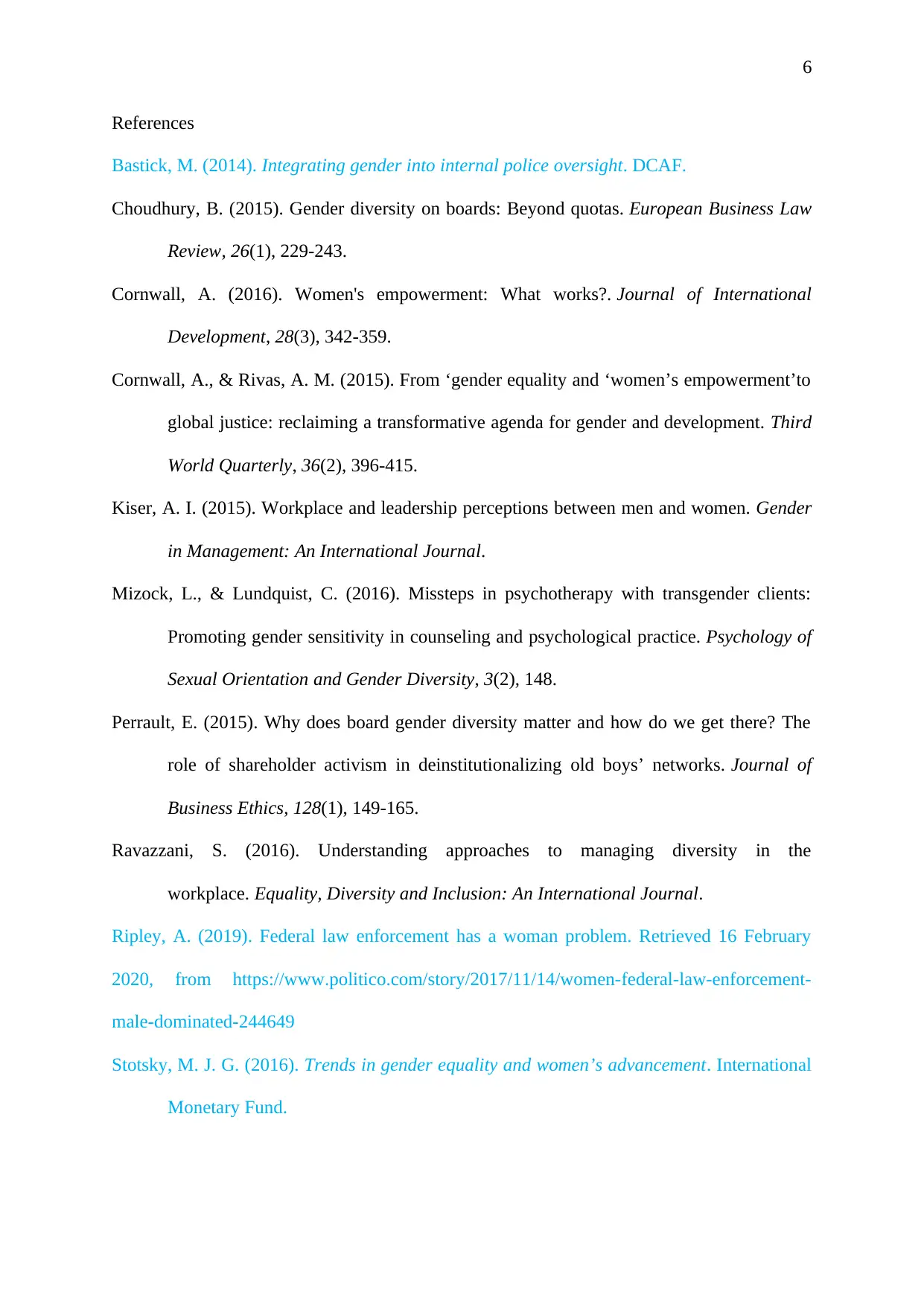
6
References
Bastick, M. (2014). Integrating gender into internal police oversight. DCAF.
Choudhury, B. (2015). Gender diversity on boards: Beyond quotas. European Business Law
Review, 26(1), 229-243.
Cornwall, A. (2016). Women's empowerment: What works?. Journal of International
Development, 28(3), 342-359.
Cornwall, A., & Rivas, A. M. (2015). From ‘gender equality and ‘women’s empowerment’to
global justice: reclaiming a transformative agenda for gender and development. Third
World Quarterly, 36(2), 396-415.
Kiser, A. I. (2015). Workplace and leadership perceptions between men and women. Gender
in Management: An International Journal.
Mizock, L., & Lundquist, C. (2016). Missteps in psychotherapy with transgender clients:
Promoting gender sensitivity in counseling and psychological practice. Psychology of
Sexual Orientation and Gender Diversity, 3(2), 148.
Perrault, E. (2015). Why does board gender diversity matter and how do we get there? The
role of shareholder activism in deinstitutionalizing old boys’ networks. Journal of
Business Ethics, 128(1), 149-165.
Ravazzani, S. (2016). Understanding approaches to managing diversity in the
workplace. Equality, Diversity and Inclusion: An International Journal.
Ripley, A. (2019). Federal law enforcement has a woman problem. Retrieved 16 February
2020, from https://www.politico.com/story/2017/11/14/women-federal-law-enforcement-
male-dominated-244649
Stotsky, M. J. G. (2016). Trends in gender equality and women’s advancement. International
Monetary Fund.
References
Bastick, M. (2014). Integrating gender into internal police oversight. DCAF.
Choudhury, B. (2015). Gender diversity on boards: Beyond quotas. European Business Law
Review, 26(1), 229-243.
Cornwall, A. (2016). Women's empowerment: What works?. Journal of International
Development, 28(3), 342-359.
Cornwall, A., & Rivas, A. M. (2015). From ‘gender equality and ‘women’s empowerment’to
global justice: reclaiming a transformative agenda for gender and development. Third
World Quarterly, 36(2), 396-415.
Kiser, A. I. (2015). Workplace and leadership perceptions between men and women. Gender
in Management: An International Journal.
Mizock, L., & Lundquist, C. (2016). Missteps in psychotherapy with transgender clients:
Promoting gender sensitivity in counseling and psychological practice. Psychology of
Sexual Orientation and Gender Diversity, 3(2), 148.
Perrault, E. (2015). Why does board gender diversity matter and how do we get there? The
role of shareholder activism in deinstitutionalizing old boys’ networks. Journal of
Business Ethics, 128(1), 149-165.
Ravazzani, S. (2016). Understanding approaches to managing diversity in the
workplace. Equality, Diversity and Inclusion: An International Journal.
Ripley, A. (2019). Federal law enforcement has a woman problem. Retrieved 16 February
2020, from https://www.politico.com/story/2017/11/14/women-federal-law-enforcement-
male-dominated-244649
Stotsky, M. J. G. (2016). Trends in gender equality and women’s advancement. International
Monetary Fund.
Paraphrase This Document
Need a fresh take? Get an instant paraphrase of this document with our AI Paraphraser

7
Veldman, J., Meeussen, L., Van Laar, C., & Phalet, K. (2017). Women (do not) belong here:
gender-work identity conflict among female police officers. Frontiers in psychology, 8, 130.
Veldman, J., Meeussen, L., Van Laar, C., & Phalet, K. (2017). Women (do not) belong here:
gender-work identity conflict among female police officers. Frontiers in psychology, 8, 130.
1 out of 8
Related Documents
Your All-in-One AI-Powered Toolkit for Academic Success.
+13062052269
info@desklib.com
Available 24*7 on WhatsApp / Email
![[object Object]](/_next/static/media/star-bottom.7253800d.svg)
Unlock your academic potential
Copyright © 2020–2025 A2Z Services. All Rights Reserved. Developed and managed by ZUCOL.




